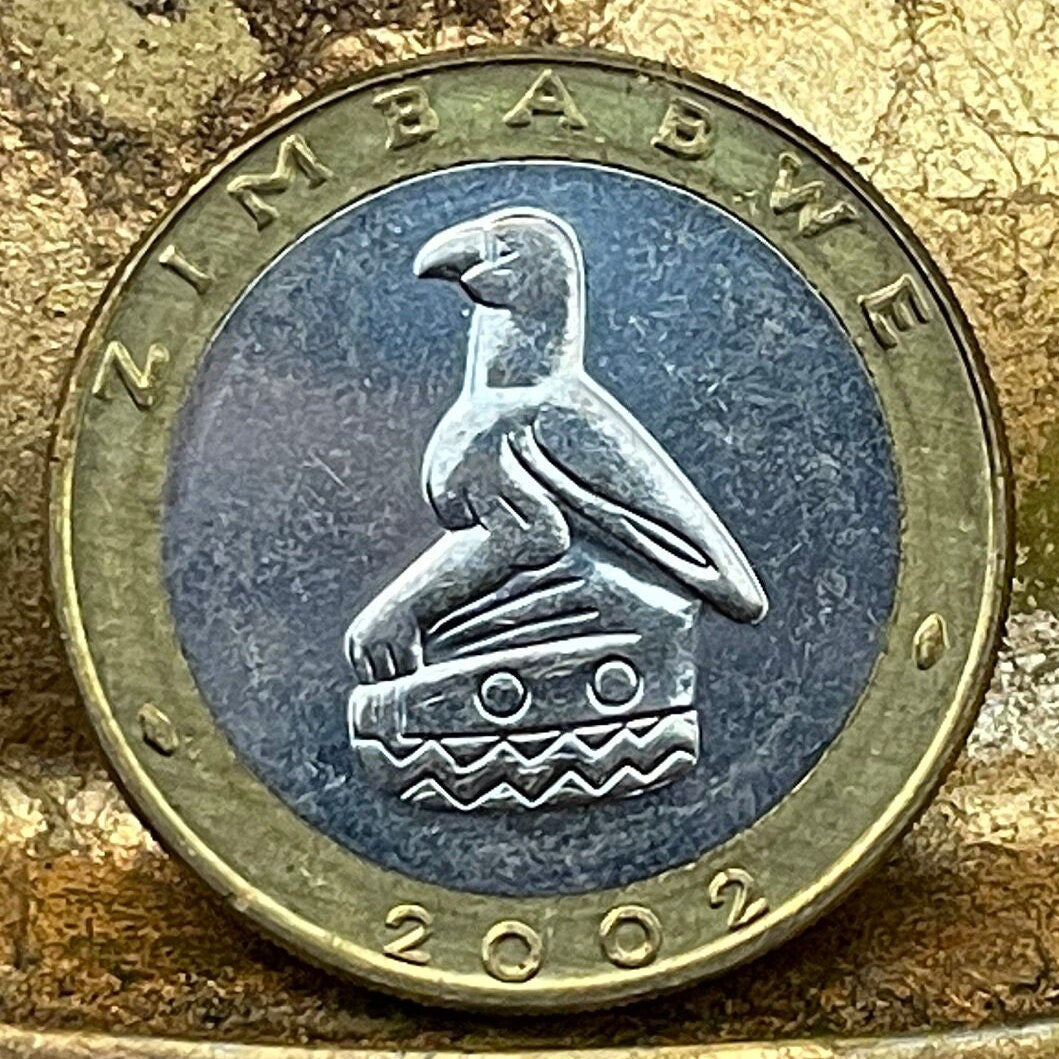elemintalshop
Black Rhinoceros & Great Zimbabwe Bird 5 Dollars Zimbabwe Authentic Coin Money for Jewelry and Craft Making (Bimetallic)
Black Rhinoceros & Great Zimbabwe Bird 5 Dollars Zimbabwe Authentic Coin Money for Jewelry and Craft Making (Bimetallic)
Couldn't load pickup availability
Black Rhinoceros & Great Zimbabwe Bird 5 Dollars Zimbabwe Authentic Coin Money for Jewelry and Craft Making (Bimetallic)
Reverse: Face value above a black rhino, Diceros bicornis, an endangered species having important populations in Zimbabwe.
Lettering: ZIMBABWE FIVE DOLLARS $5
Obverse: Representation of the protective bird, the most famous of Zimbabwe sculptures dated between XII and XIV century. Protective sculpture in the city of Great Zimbabwe, the capital of Monomotapa Empire and led Gokomere ancestors of Shona, the people of southern Africa.
Lettering: ZIMBABWE
Features
Issuer Zimbabwe
Period Republic (1980-date)
Type Standard circulation coin
Years 2001-2003
Value 5 Dollars (5.00 ZWD)
Currency First Dollar (1980-2006)
Composition Bimetallic: nickel plated steel center in brass ring
Weight 9.05 g
Diameter 27.4 mm
Thickness 2.05 mm
Shape Round
Orientation Medal alignment ↑↑
Demonetized Yes
Number N# 10347
References KM# 13, Schön# 62
Wikipedia:
The black rhinoceros or hook-lipped rhinoceros (Diceros bicornis) is a species of rhinoceros, native to eastern and southern Africa including Angola, Botswana, Kenya, Malawi, Mozambique, Namibia, South Africa, Eswatini, Tanzania, Zambia, and Zimbabwe. Although the rhinoceros is referred to as black, its colours vary from brown to grey.
The other African rhinoceros is the white rhinoceros (Ceratotherium simum). The word "white" in the name "white rhinoceros" is often said to be a misinterpretation of the Afrikaans word wyd (Dutch wijd) meaning wide, referring to its square upper lip, as opposed to the pointed or hooked lip of the black rhinoceros. These species are now sometimes referred to as the square-lipped (for white) or hook-lipped (for black) rhinoceros.
The species overall is classified as critically endangered (even though the south-western black rhinoceros is classified as near threatened). Three subspecies have been declared extinct, including the western black rhinoceros, which was declared extinct by the International Union for Conservation of Nature (IUCN) in 2011.
Illegal poaching for the international rhino horn trade is the main and most detrimental threat. The killing of these animals is not unique to modern-day society. The Chinese have maintained reliable documents of these happenings dating back to 1200 B.C. The ancient Chinese often hunted rhino horn for the making of wine cups, as well as the rhino's skin to manufacture imperial crowns, belts and armor for soldiers. A major market for rhino horn has historically been in the Middle East nations to make ornately carved handles for ceremonial daggers called jambiyas. Demand for these exploded in the 1970s, causing the black rhinoceros population to decline 96% between 1970 and 1992. The horn is also used in traditional Chinese medicine, and is said by herbalists to be able to revive comatose patients, facilitate exorcisms and various methods of detoxification, cure fevers, and aid male sexual stamina and fertility. It is also hunted for the superstitious belief that the horns allow direct access to Heaven due to their unique location and hollow nature. The purported effectiveness of the use of rhino horn in treating any illness has not been confirmed, or even suggested, by medical science.
*******
Wikipedia:
The stone-carved Zimbabwe Bird is the national emblem of Zimbabwe, appearing on the national flags and coats of arms of both Zimbabwe and Rhodesia, as well as on banknotes and coins (first on the Rhodesian pound and then on the Rhodesian dollar). It probably represents the bateleur eagle or the African fish eagle. The bird's design is derived from a number of soapstone sculptures found in the ruins of the ancient city of Great Zimbabwe.
It is now the definitive icon of Zimbabwe, with Matenga (2001) listing over 100 organisations which now incorporate the Bird in their logo.
The original carved birds are from the ruined city of Great Zimbabwe, which was built by ancestors of the Shona, starting in the 11th century and inhabited for over 300 years. The ruins, after which modern Zimbabwe was named, cover some 730 hectares (1,800 acres) and are the largest ancient stone construction in sub-Saharan Africa. Among its notable elements are the soapstone bird sculptures, about 40 centimetres (16 inches) tall and standing on columns more than 90 cm (3 ft) tall, which were originally installed on walls and monoliths within the city. They are unique to Great Zimbabwe; nothing like them has been discovered elsewhere.
Various explanations have been advanced to explain the symbolic meaning of the birds. One suggestion is that each bird was erected in turn to represent a new king, but this would have required improbably long reigns. More probably, the Zimbabwe birds represent sacred or totemic animals of the Shona – the bateleur eagle (Shona: chapungu), which was held to be a messenger from Mwari (God) and the ancestors, or the fish eagle (hungwe) which it has been suggested was the original totem of the Shona.
Share









Beautiful coin. I hope to see a Black Rhinoceros in South Africa on my safari trip. Well packaged in individual coin containers. Fast shipping. Thank you.
thank you!
5 stars review from Robert
5 stars review from Vicki








